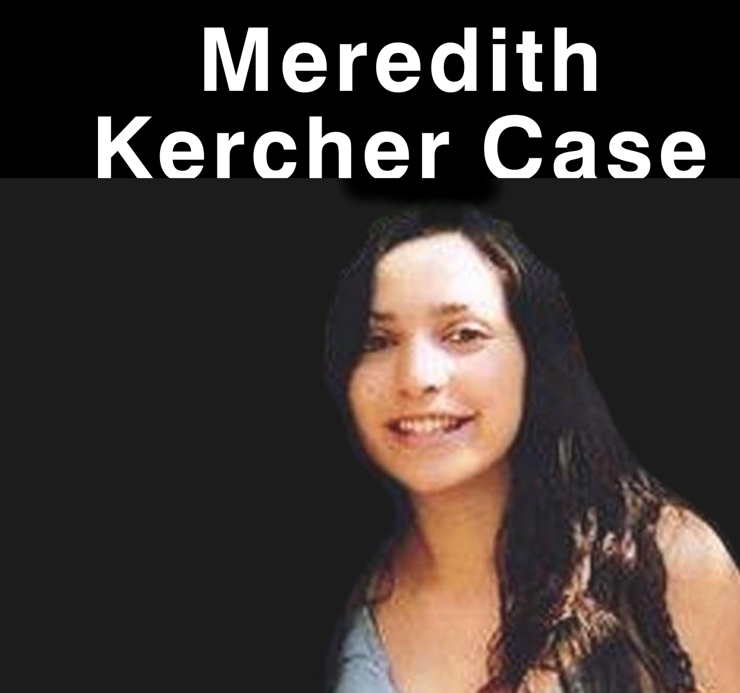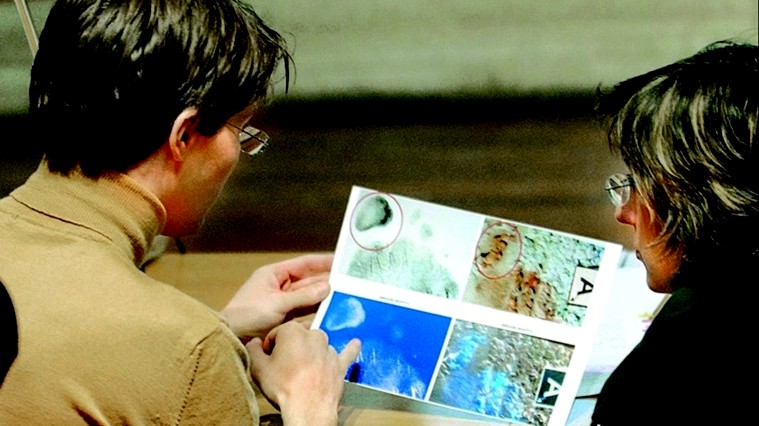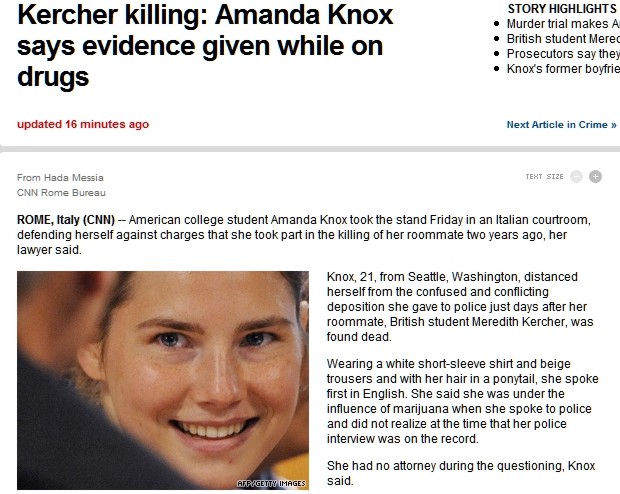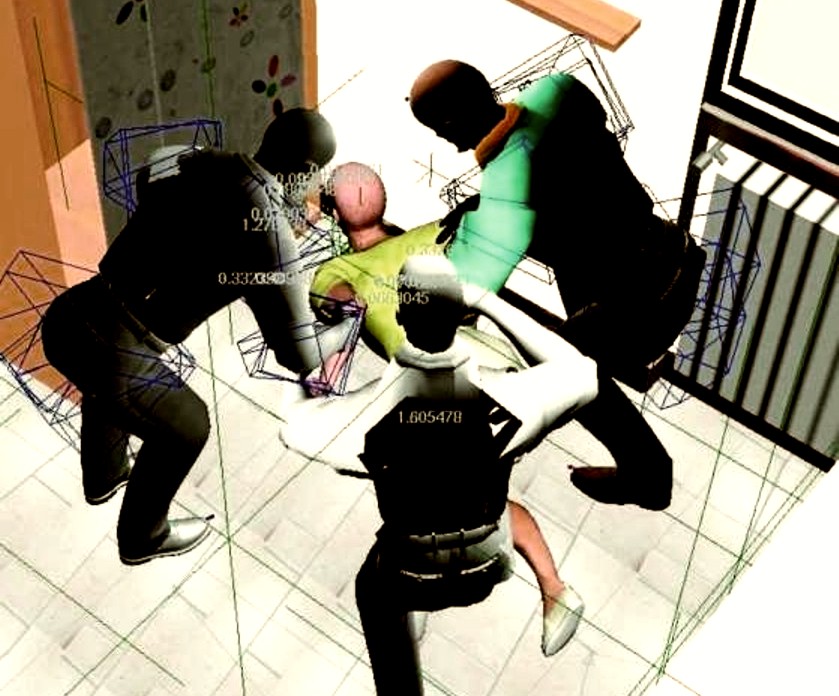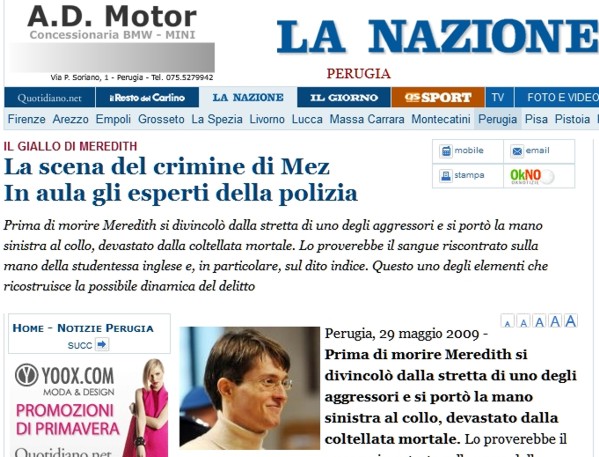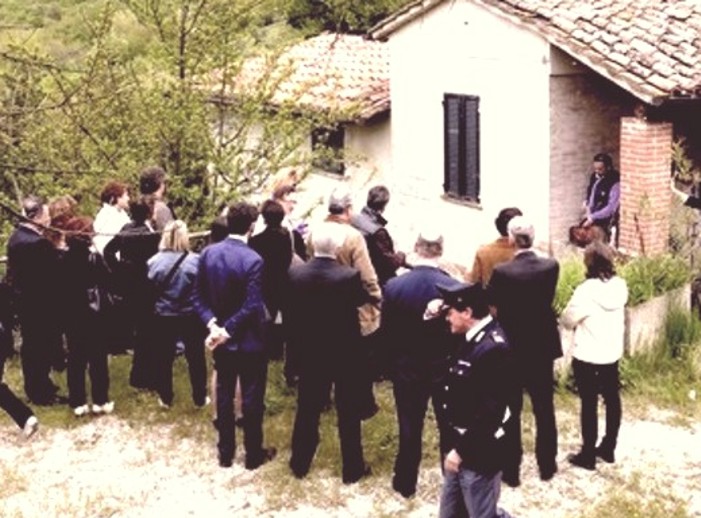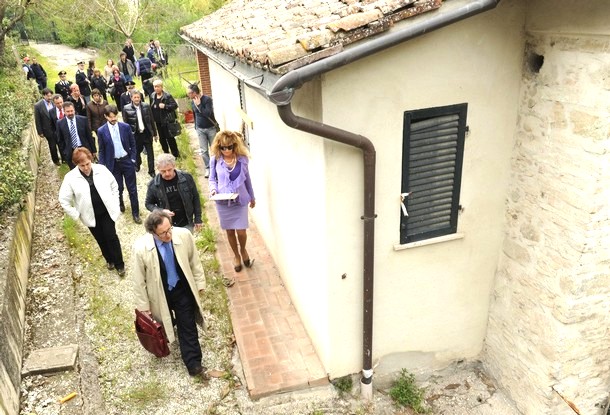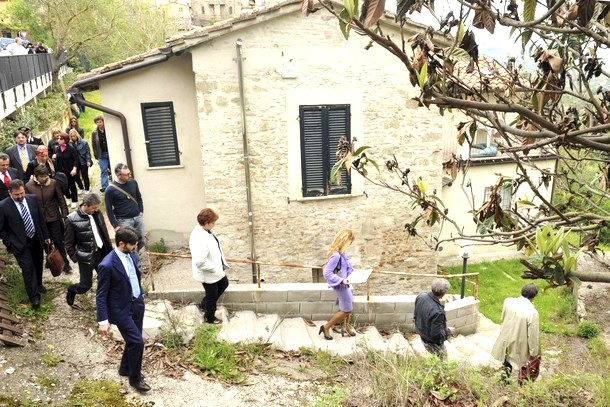
Headsup: The deep expose with associated comments below was first posted by Finn MacCool on 12/20/13. Knox's failed calunnia trial in 2009, failed 1st appeal in 2011, and failed final appeal in 2013 had come and gone. Some 500 zombie misrepresentations had recently reappeared in Knox's English-only 2013 book. See main support documents here and also (vitally) this and this and this.
Category: Massei prosecution
Thursday, July 30, 2009
Case For The Prosecution: #3 Raffele Sollecito’s Multiple Conflicting Alibis
Posted by The Machine
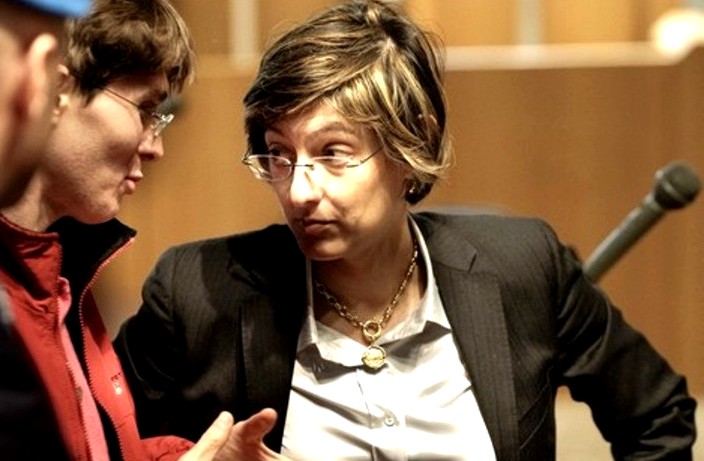
[above: Sollecito with his lawyer Giulia Bongiorno; click for a larger image]
The Sollecito Alibis: How They Conflict
The first two posts on the power of the case were on the DNA evidence, and the luminol-enhanced footprint evidence.
In this and the next post we will elaborate upon the testimony relevant to the multiple alibis given by Amanda Knox and Raffaele Sollecito and the evolving circumstances in which they were given.
Following the discovery of Meredith’s body in her house, more than a dozen possible witnesses were quite expeditiously questioned: Meredith’s various English friends, her two Italian housemates, the four boys who lived downstairs, and Knox and Sollecito.
Meredith’s English friends, her two Italian housemates, and the boys downstairs fully cooperated with the police. They seemed to be telling the truth. They had one alibi each that could readily be verified. Those alibis never changed.
As a direct result they were all quickly eliminated from the investigation.
In stark contrast, Amanda Knox and Raffaele Sollecito appeared to be obfuscating. They appeared callous, impatient, arrogant, and reluctant to cooperate with the police.
These were attitudes first publicly noted as incriminating in mid 2008 by the judges at the Italian Supreme Court. Police and prosecution did not leak.
Knox and Sollecito each made three separate attempts to come up with credible alibis. All appeared desperate and semi-rehearsed. None of them made total sense or managed to get them off the hook. Neither helped the other at all.
Today, we address Sollecito’s alibis.
The prosecution undermined them in various ways. Sollecito did not take the stand at trial to repeat any of them. His occasional interventions in the courtroom did not strengthen any of them. He made no attempt to corroborate the third alibi of Knox (that she was at his place all night) and immediately prior to arrest he said she had made him lie.
Everyone at and around trial knew of the wariness and extreme anger of the two (and their families) and how they knocked chips off one another whenever they could.
Innocent behavior? You decide. If each was not blaming the other for their plight this behavior would be unique in the history of crime.
Raffaele Sollecito’s first alibi
For his first alibi Raffaele Sollecito claimed, in an interview with Kate Mansey from the Sunday Mirror, that he and Amanda Knox were at a friend’s party on the night of the murder. It appears that this is the alibi that Sollecito also first told the police.
As there seems to have been no party, or in any case no party they attended, it would have been difficult for Sollecito to find any witnesses, and so this alibi was quickly superceded.
Raffaele Sollecito’s second alibi
For his second alibi Sollecito now claimed that he was at his apartment throughout the night with Amanda Knox.
This alibi was contradicted by the forensic evidence presented by the prosecution. According to the testimony of the scientific police from Rome, there were six separate pieces of forensic evidence that placed him in the cottage on Via Della Pergola on the night of the murder.
These included an abundant amount of his DNA on Meredith’s bra clasp, and a bloody footprint on the blue bathmat in Meredith’s bathroom which appears to match the precise characteristics of his foot.
Sollecito’s claim that he was at his apartment the whole evening on 1 November was also undermined by Amanda Knox, who claimed in one of her own witness statements that he was also at the cottage when Meredith was killed:
Yes we were in the house. That evening we wanted to have a bit of fun. We were drunk. We asked her to join us. Diya wanted her. Raffaele and I went into another room and then I heard screams.
This alibi was also undermined by an eyewitness, Antonio Curatolo, the watcher in the park above the house, who testified that he saw Sollecito there. And it was undermined by Sollecito himself when he moved to the third alibi below.
In my previous statement I told a load of rubbish because Amanda had convinced me of her version of the facts and I didn’t think about the inconsistencies.
Although Rudy Guede exercised his right to silence when he was called as a witness in the present trial, it should be noted that at his own trial last October and in the stated grounds for his appeal, he has claimed that Amanda Knox and Raffaele Sollecito were both at the cottage on the night in question, and that they were responsible for Meredith’s murder.
Raffaele Sollecito’s third alibi
Sollecito was asked to return to the police station on 5 November to answer some more questions. He was at that time confronted with telephone records that proved that he and Amanda Knox had lied previously.
So for his third alibi, which now cut Amanda Knox loose and implicated her, Sollecito claimed that he was at his apartment all evening, and that for part of the evening Knox was out, from 9 pm to 1 am.
In my previous statement I told a load of rubbish because Amanda had convinced me of her version of the facts and I didn’t think about the inconsistencies….
Amanda and I went into town at around 6pm, but I don’t remember what we did. We stayed there until around 8.30 or 9pm.
At 9pm I went home alone and Amanda said that she was going to Le Chic because she wanted to meet some friends. We said goodbye. I went home, I rolled myself a spliff and made some dinner.”
He goes on to say that Amanda returned to his house at around 1am and the couple went to bed, although he couldn’t remember if they had sex.
This third alibi was undercut by Amanda Knox when she took the stand and testified. She stated that she was with Sollecito at his place all night.
It was also contradicted by the forensic evidence presented by the prosecution: the six separate pieces of forensic evidence that placed him in the cottage on Via Della Pergola on the night of the murder.
This third alibi was also undermined by the telephone records and by the data taken from his computer.
Sollecito claimed that he had spoken to his father at 11 pm. The phone records showed that to the contrary, there was no telephone conversation at this time, though Sollecito’s father had called him a couple of hours earlier, at 8.40 pm.
Sollecito claimed that he was surfing the internet from 11 pm to 1 am. Marco Trotta, a police computer expert, testified that the last human interaction on Sollecito’s computer that evening was at 9.10 pm and the next human activity on Sollecito’s computer was at 5.32 am.
Sollecito said that he downloaded and watched the film Amelie during the night. However, Mr Trotta said that the film had been watched at around 6.30 pm, and it was earlier testified that Meredith returned to the cottage she shared with Amanda Knox at about 9 pm.
Sollecito claimed that he had slept in until 10 am the next day. There was expert prosecution testimony that his mobile phone was actually turned on at 6.02 am. The Italian Supreme Court remarked that his night must have been “sleepless” to say the least.
This alibi was undermined by the eyewitness Antonio Curatolo, the watcher in the park above the house, who testified that he saw Sollecito there.
Sollecito’s difficult situation resulting
Sollecito does not seem to have done himself any favours by exercising his right to remain silent and not to testify at the trial.
As things now stand, he does not have any credible alibi or scenario for the night of the murder. Also it would appear that he has damaged his overall credibility irreparably, by giving three alibis that differed so considerably.
Judge Paolo Micheli had in front of him much of the same evidence. He wrote, in committing Raffaele Sollecito to trial last October, that he considered the triple alibis to be a clear indication of guilt.
There seems to be no obvious reason right now why the present judges and jury would conclude differently.
Thursday, July 23, 2009
Case For The Prosecution: #2 The Tough Footprint Evidence
Posted by The Machine
1. Preamble
This series is a summary of the prosecution’s case in five parts, with a commentary on matters of key significance.
The material has been reordered so that evidence presented at several points in the trial can be described in one post here. Sources used are the many published reports and some transcripts made of the testimony. The first post, below, was on the formidable DNA evidence.
In this post we now elaborate the footprint evidence, some of which is easily visible and some of which is only apparent with the use of luminol.
We reported what happened in the court here and here.
Kermit in his Powerpoint series provided us with accurate prior analysis and post analysis of these flootprints and shoeprints, and Kermit also presented a Powerpoint map of the cottage.
2. About luminol
Luminol is a chemical that reacts with the microscopic particles of iron in the blood if a partial but incomplete attempt has been made to clean a bloodstain away.
The blood traces glow a bright blue quite fleetingly in the dark under luminol, just long enough to allow forensic investigators to measure and photograph it.
Luminol evidence can be among the most compelling. If bloodstains show up under luminol, but not to the naked eye, then it is almost a complete certainty that a crime-scene clean-up has been attempted.
Lorenzo Rinaldi is the director of the print-identity division of Italy’s scientific police, the Italian equivalent of Scotland Yard or the FBI. He testified that one visible and three luminol-revealed footprints and a visible shoeprint belonged to the present two defendants, Amanda Knox and Raffaele Sollecito. (Another shoeprint belonged to Guede, convicted last October.)
3. Evidence Against Amanda Knox
Amanda Knox’s footprints were found set in Meredith’s blood in two places in the hallway of the new wing of Meredith’s house. . One print was exiting her own room, and one print was outside Meredith’s room, facing into the room. These bloody footprints were only revealed under luminol.
The fact that there was an absence of any visible bloody footprints from Meredith’s room where Meredith’s blood was to the visible bloody footprint on the blue bathmat in the bathroom that Meredith and Knox shared strongly indicates that some prints were successfully cleaned away altogether.
A woman’s bloody shoeprint which matched Amanda Knox’s foot size was found on a pillow under Meredith’s body. Barbie Nadeau noted the significance of this evidence on The Daily Beast website:
“When the judge asked Rinaldi the size of an unidentified bloody shoeprint found on the pillow below Kercher’s body, he responded, “Between 36 and 38.” The judge then asked Rinaldi what size shoe Knox wears. “The Skecher shoe we sequestered belonging to Amanda Knox corresponds with size 37.”
The significance of the woman’s bloody shoeprint in Meredith’s room is considerable. By itself it debunks the myth that some had propagated for a while, that Rudy Guede acted alone. The bloody shoeprint was incompatible with Meredith’s shoe size.
4. Raffaele Sollecito
Two bloody footprints were attributed to Raffaele Sollecito. One of them was revealed by luminol in the hallway, and the other one was easily visible to the naked eye on the blue bathmat in Meredith’s and Knox’s shared bathroom.
Lorenzo Rinaldi excluded the possibility that the bloody footprint on the blue bathmat was the right size or shape to belong to Knox or Guede instead of Sollecito: “You can see clearly that this bloody footprint on the rug does not belong to Mr. Guede, but you can see that it is compatible with Sollecito.”
Andrea Vogt’s report for the Seattle Post-Intelligencer shows just how meticulous and painstakingly detailed the analysis of the bloody footprints was:
“All the elements are compatible with Mr. Sollecito’s foot,” Rinaldi said, pointing with a red laser to a millimeter-by-millimeter analysis of Sollecito’s footprint projected onto a big-screen in the courtroom. He used similar methods to exclude that the footprint on the bath mat could possibly be Guede’s or Knox’s.
“Those bare footprints cannot be mine,” said Sollecito in a spontaneous statement…. But the next witness, another print expert, again confirmed Rinaldi’s testimony, that the print, which only shows the top half of the foot, matches the precise characteristics of Sollecito’s foot….
Rinaldi’s detailed PPT described methods of image analysis, metric and grid measurement of the ball, toe, heel and arch, as well the particular characteristics of the footprints and shoeprints as well as the actual shoes and feet of Knox, Sollecito and Guede. The three suspects gave their footprints and fingerprints at police headquarters.”
Another print expert also testified that the bloody footprint on the blue bathmat matched the precise characteristics of Sollecito’s foot.
Amanda Knox’s lawyer, Luciano Ghirga, asked Dr. Stefanoni to confirm that other substances like bleach or fruit juice can also react to luminol.
Dr. Stefanoni acknowledged that they do, but pointed out that biologists who work regularly on crime scenes distinguish easily between the bright blue glow of a blood trace and the much fainter glow from other reactive substances
Tuesday, July 21, 2009
Case For The Prosecution: #1 The DNA Evidence
Posted by The Machine
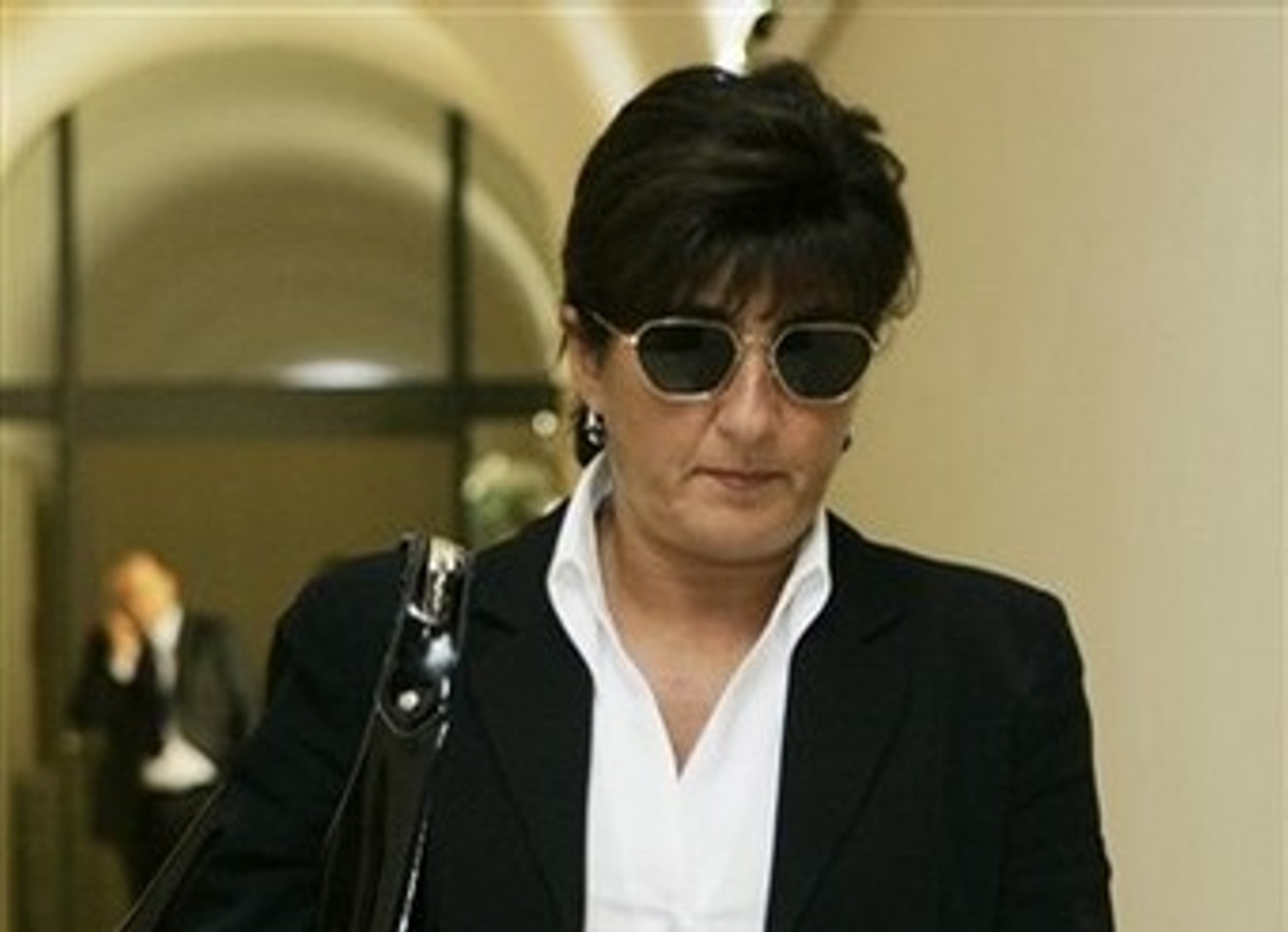
[Above: Prosecutor Manuela Comodi, click for larger image]
1. Preamble
Nearly 200 hours over 23 days.
That is how long the prosecution took to present its voluminous case against Amanda Knox and Raffaele Sollecito, including time taken by the defense teams to conduct cross-examinations.
This series is a summary of the prosecution’s case in five parts, with a commentary on matters of key significance. The material has been reordered so that for example the DNA evidence presented at several points in the trial can all be described in one post here.
Sources used are the many published reports and some transcripts made of the testimony. All the main witnesses will be named in this series with a brief mention of who they are and their qualifications.
Two past posts that may aid in understanding the DNA testimony are Nicki’s post here and Fiori’s post here. All past DNA posts can be found in this area.
2. The Large Double DNA Kitchen Knife
The double DNA knife is the knife that was sequestered from Sollecito’s apartment. Although there was an imprint of another knife at the scene, and one defense expert argued that there may have been yet another, it remains plausible that this is the weapon that was used to murder Meredith.
Dr. Patrizia Stefanoni was the leader of the forensic team from Rome that carried out all the forensic collections at Meredith’s house. She testified unequivocally about the knife. A small sample of Meredith’s DNA was found to be in a groove on the blade, and Amanda Knox’s DNA was found to be on the handle.
Dr. Stefanoni noted that there were peculiar diagonal scrapes on the knife blade, which suggested that the knife had been vigorously cleaned.
Both Dr. Renato Biondo, the head of the DNA Unit of the scientific police, and the Kerchers’ own DNA expert, Professor Francesca Torricelli, provided independent confirmation that this forensic finding is accurate and reliable.
The defence teams’ forensic experts are not disputing that Meredith’s DNA was on the blade of the knife. Instead they are arguing that the knife was somehow contaminated for the DNA to actually be there.
Dr Stefanoni has firmly excluded this possibility of contamination in transit or in the laboratory. She testified that there hasn’t been a single instance of contamination in her laboratory for at least the last seven years, and every precaution was taken here to ensure that different traces were not mixed.
A police officer who led a search of Sollecito’s apartment added weight to the prosecution’s assertion that the double DNA knife had been cleaned with bleach. He testified that he had been struck by “the powerful smell of bleach”.
When Raffaele Sollecito heard that the scientific police had found Meredith’s DNA on the double DNA knife in his apartment, he did not deny the possibility of the DNA being there.
Instead he made a claim about accidentally pricking Meredith’s hand whilst cooking at his apartment. “The fact that Meredith’s DNA is on my kitchen knife is because once, when we were all cooking together, I accidentally pricked her hand.’‘
However Meredith had never been to Sollecito’s apartment and so it seems Sollecito could not have accidentally pricked her hand there whilst he was cooking. In attempting to explain the presence of Meredith’s DNA on the blade, he did so in a way easily disproved and seemed to further implicate Amanda Knox and himself.
3. Sollecito’s DNA On Meredith’s Bra Clasp
An abundant amount of Raffaele Sollecito’s DNA was found on Meredith’s bra clasp, and Dr. Stefanoni has excluded the possibility of any contamination.
This is the bra clasp that was collected some weeks after the first forensic collection and it was conceded that it should have been collected earlier. It was also argued that valid DNA evidence in other cases is often collected weeks or months or even years after the crime when a suspect object is unearthed.
Sollecito’s lawyer Ms Buongiorno is perhaps not surprisingly claiming that this bra clasp was also contaminated in the laboratory. The problem for them is to explain precisely where such an abundant amount of Sollecito’s DNA could have come from, and how it was so firmly imprinted.
The only other instance of Sollecito’s DNA at the cottage was found on a cigarette butt in the kitchen, seemingly an unlikely source at best.
It would seem unlikely that the judges and jury will conclude that the bra clasp was contaminated in a strictly controlled laboratory where Dr. Stefanoni follows rigorous laboratory procedures. She is an internationally renowned and very experienced forensic expert and was part of a Disaster Investigations Team which identified disaster victims via their DNA.
Alberto Intini is the head of the Italian police forensic science unit. Andrea Vogt reported as follows in the Seattle Post-Intelligencer on Mr Intini’s testimony about the possibility or otherwise of contamination:
“Alberto Intini maintained that the crime scene had not been contaminated and pointed out that laboratory testing revealed none of the investigators’ prints or biological traces. Mr Intini said “In fact, it is the results that tell you if it was done correctly, and I can tell you that in this investigation there was not even one trace of any of our operators.”
He also pointed out that unless contamination has been proved, it does not exist. “It is possible in the abstract that there could have been contamination, but until this is proved, it does not exist.”
The prosecution demonstrated on the final full day of testimony that Meredith’s bra was actually removed with a knife some time after she had been killed.
Judge Paolo Micheli presided over the fast-track trial of Rudy Guede and committed Sollecito and Knox to trial. In looking at the identical evidence he asked “Who had a reason to come back, cut off Meredith’s bra, and move her body some time later?”
The present judges and jury might conclude differently, but Judge Micheli concluded that it would only have been done by someone who knew about Meredith’s death and had an interest in arranging the scene in Meredith’s room to point away from themselves. He discounted Rudy Guede, who apparently went home, cleaned himself up, and then was seen out on the town.
4. Knox Blood With Meredith’s
There were five instances of Amanda Knox’s blood or DNA mixed with Meredith’s blood in three different locations in the cottage in Via della Pergola: the bathroom, the hallway, and Filomena’s bedroom.
Amanda Knox’s blood was found mingled with Meredith’s blood in three places in the bathroom: on the ledge of the basin, on the bidet, and on a box of Q Tips cotton swabs.
Dr. Stefanoni testified that it would have been “strange” that three traces of blood with both Meredith’s and Amanda Knox’s DNA would have been left at different times.
Barbie Nadeau in Newsweek pointed out a reason why the blood stains must have been left on the night of the murder:
“Legal experts who follow this case have suggested that blood evidence cannot be dated and therefore could have been left weeks before the murder. But when Knox testified in her own defense in June, she conceded that there was no blood in the bathroom the day before the murder, effectively dating those blood stains to that night.”
Perhaps Knox had a bloody earring piercing, and maybe a drop landed on a drop of Meredith’s blood. But in three different places? Perhaps it is not surprising that the defence lawyers have not brought up the subject of the mixed DNA in the bathroom in their part of the trial.
Meredith’s blood was found on the top part of the light switch in the bathroom she shared with Amanda Knox. This suggests that it was deposited there when the light was switched on. Meredith’s blood was also found on the toilet lid. There were no DNA or other physical traces of Rudy Guede in that bathroom.
Knox’s DNA and Meredith’s DNA was also found mixed together in a bloody footprint in the hallway of the new wing of the house.
A mixture of Knox’s DNA and Meredith’s blood was also found in Filomena’s room. This seems to be compelling evidence because Knox had never claimed she entered Filomena’s room when she checked the cottage. This room was the scene of the alleged break-in, and there were glass fragments on the floor.
Meredith’s blood had been cleaned up in this room, but it was nevertheless revealed by luminol.
Barbie Nadeau concludes in a Daily Beast report that the mixture of Knox’s DNA and Meredith’s blood in Filomena’s room seems more incriminating than the double DNA knife:
“But perhaps more damning even than the knife was Stefanoni’s testimony that a mix of Knox’s DNA and Kercher’s blood was found on the floor in the bedroom of a third roommate, Filomena Romanelli.”
Saturday, July 11, 2009
It Is The Jury That Ultimately Matters: How They May Be Seeing The DNA Here
Posted by Fiori
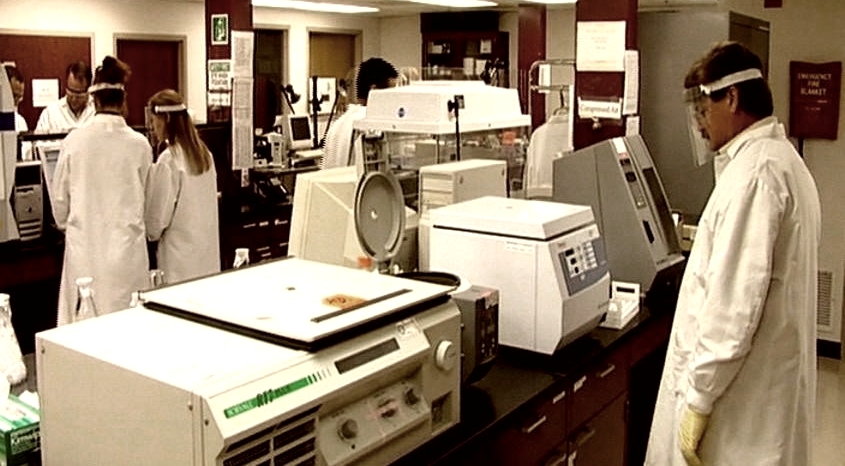
Example of well-equipped Italian DNA lab
Ciao! Posting again from Florence.
Nicki and Kermit have already done amazing work here and here in explaining the hard facts of the DNA evidence.
This post is about perceptions and about what the judges and jury might - might - now be thinking, now that those facts are presented and some of them contested.
DNA evidence is notoriously hard to present and argue before a jury. It is not only in the trial against Amanda and Rafaelle that one finds problems, ambiguities and different interpretations of the validity and reliability of DNA, this is the same in many criminal trials.
Standardization of DNA testing procedures got an enormous boost by the unforeseen “accident” in the OJ Simpson’s trial, where the jury, according to all scientific authorities, failed to recognize the DNA evidence properly. Since than the overall public understanding of DNA has been increasing, and jurors and others agents have earned a familiarity with handling DNA in criminal trials. All this suggests that it is generally getting easier for jurors to understand when and how DNA is significant in a trial.
It is of great importance to underline that the jury is the crux of every case: No matter what Dr. Stefanoni knows and how she may have handled the DNA samples, it is the jury, this particular selection of individuals, which has to make sense of the testimonies, and form an understanding of what the DNA samples tells about the murder of Meredith and the possibly involvement of Amanda and Rafaelle (and Rudy). I emphasize this:
- Jurors are not a scientific committee, and the way which a jury understands DNA differs considerably from a professional, scientific understanding of DNA
- Jurors’ understanding of DNA is highly situational; i.e. it is heavily influenced by how, when and by whom DNA material is presented during the trial
- Jurors build their comprehension from context, meaning that a jury does not base their understanding upon systematically selected information about DNA, but forms an opinion based upon an interrelation of scientifically based information and the circumstances of the present case
Findings from the US and UK system of justice
What characterizes jurors’ judgments of DNA material in criminal trials? It is usual to expect that the more scientifically complex a piece of evidence is, the more difficult is it for a jury to comprehend, but from studies in UK, US and Australia several other things are known:
- Among jurors who were aware of DNA profiling evidence before their participation in the researched trials, expectations for the evidence in determining the guilt or innocence of an accused were high, and these expectations were largely confirmed by the jury members experiences of the trial itself.
- Juror comprehension of DNA evidence is not solely dependent on the scientific complexity of the evidence. If the evidence is presented clearly in court, if the expert testimony is consistent, if the defences do not present contrary interpretations of the DNA evidence, and the case is otherwise circumstantial, then jurors seem to manage a fair understanding of the science and weight it significantly in case material.
- The strength of the defence challenge may depend on the coherence and grounding of an alternative explanation or conclusion drawn from the DNA. Meaning: it is NOT generally so, that IF a piece of DNA evidence is NOT contradicted by the defence, then it is easier for a jury to comprehend DNA evidence. HOW a jury interprets DNA evidence depends upon the context of the PRESENTATION of the evidence.
Research into US trials reports that jurors mostly are much more skeptical toward DNA evidence than statistics gives reason for. The jurors often “incorrectly aggregate separately presented probabilities and afford probabilistic evidence less weight than would be expected [by experts]” and “their background beliefs about the possibility of laboratory errors and intentional tampering affects the weight participants afford a DNA match report.”
A juror’s interpretation of expert testimonies is highly influenced by the credibility they assign to the legal and scientific system; i.e. all the institutions involved in a trial: the police, the legal system, the forensic police, and scientific institutions in general.
The point made here is that jurors and legal systems have “historical memory” so the result of one trial influences the outcome of another: Thus, it is possibly that the OJ Simpson case and the many faulty convictions based upon DNA “˜evidence’ has produced a overt negative attitude towards DNA in the US, which is not to be expected to be the same in Italy.
Another conclusion, also from research within the US: Cognitive errors favoring the defence were more prevalent than errors ones favoring the prosecution. This piece of research examines how jurors’ evaluates that part of the DNA testimony which involves probabilities and statistics. And as this touches upon core questions brought up in the case against Amanda and Rafaelle, I will quote in length from the paper.
- The paper, which studies the outcome of several (murder) trials - concludes that “some jurors showed susceptibility to classic (defence) fallacies in interpreting conditional probabilities, and the jurors as a group were not overwhelmed by testimony from a prosecution expert that “˜more than 99.98% of all Caucasians would be excluded’ by the DNA match.
Most jurors accepted a defence criticism of this computation. Moreover, it appears that many jurors were inclined to agree with the defendant’s overstated argument that because dozens of men in the area might have DNA types consistent with those of the robber, the match with the defendant’s DNA was worthless. A smaller number seemed to commit what has been called the “˜prosecutor’s fallacy.’ These jurors did muddle up the proportion of the general population that would be excluded by a DNA test, and the probability that the defendant was the source of the crime-scene DNA.
On balance, these findings do not indicate that jurors generally were unduly impressed by the prosecution’s DNA evidence. Consequently, our results challenge the legal argument that DNA evidence should be excluded because jurors are prone to overvalue such evidence.”
So, measured in relation to the expert testimony actually given in court, this research found that jurors made misunderstandings and misinterpretations biased BOTH ways. The research did not find jurors to be “˜unduly impressed’ by prosecutions experts testimony, but instead being “˜susceptible’ in favour of the defence.
But other research indicates that some jurors are being too impressed by the DNA evidence or mislead by the statistics presented in court.
Research from UK and US, states that “a number of convictions which have relied on DNA evidence have been overturned on appeal on the basis of misdirection of the jury regarding the statistical basis of the test and its results. In particular, juries are often awe-struck by the enormous values of random occurrence ratio with which they are presented by the prosecution experts. The factual significance of these large numbers is often misunderstood and misrepresented by barristers and judges, leading to unsafe convictions.”
Then, not only the jurors, but the legal actors more widely have problems with understanding how the statistical dimensions of DNA evidence works. The point of the statistics is, that identifying the DNA markers can be misleading if identification of the suspect occurs on behalf of “˜random occurrence ratios’ ““ i.e. the suspect is identified in random by her DNA (similar to how fingerprint identification works).
Identification on behalf of DNA must relate to the demography of the area where the crime took place, as well as the family background of the suspect. Meaning that statistics can be misleading if identification is not supported by additional information (where much exists in the trial against Amanda and Rafaelle). Dr. Stefanoni has repeatedly argued this point in court, explaining why Amanda’s DNA is Amanda’s, and Rafaelle’s DNA is Rafaelle’s, and not a “˜random’ person, like an unknown friend of Rudy’s.
From research into the working of the US and the UK legal systems, it must be clear that most of the news-reports from the US about the murder of Meredith Kercher tend to reinforce a common deficit in knowledge on how to interpret DNA evidence. A shame that.
Also worth mentioning is that the OJ Simpson trial is not the only one where “˜scientifically’ obvious DNA evidence have been disregarded by a jury; this also seen in cases where there presented a lot of other circumstantial evidence supporting the DNA material.
And that different interpretation (prosecution and defence) of DNA material does not in itself blur jurors comprehension and prevent an unanimous understanding of the significance. Contrary, controversies over DNA can serve to clarify a juror’s understanding of DNA.
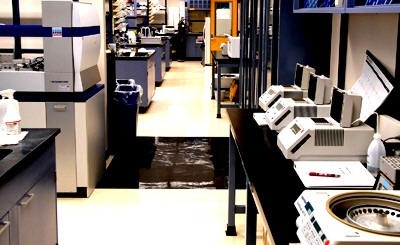
Example of well-equipped Italian DNA lab
Likely differences under the Italian system of justice
These results from research into the US/UK type of legal system should be discussed in relation to the working of the Italian system. And there are, in this perspective, significant differences.
In Italy, a jury consists of 6 lay persons and 2 professional judges. It is highly likely that the participation of 2 professional judges influences how the jury perceives and discusses DNA and other complex scientific matters. The above quoted research into fallacies of comprehending DNA evidence can only support the view that it is a strength of the Italian system that professional judges are represented in the jury.
Also, the Italian trial system, where parts of evidence are presented and assessed by multiple judges in many pre-trial hearings, also marks a difference vis a vis the US system. Every (pre-) trial adds to jurors possibility to comprehend DNA material correct (”˜correct’ in relation to understanding what is actually testified in court, not “˜correct’ in relation to assessing the significance of the DNA material as evidence).
As referred to above, pre-trial experiences also influences how jurors interpret DNA testimony.
Then education, schools and general cultural education (”˜bildung’ in German), cultural habits (for example if criminal trials are broadcast or not, and if they are watched widely or not) will without doubt influence how jurors comprehend DNA evidence. And of course so will criteria used by the court for selecting the actual jury influence the outcome; for example if it was considered important that jury members demonstrated ability to understand complex scientific arguments.
Generally, European comparative test shows that primary education in Italy are in the upper middle, and Italy has very good universities and strong academic traditions, and ““ not the least - a long and proud tradition in science from Leonardo da Vinci and onwards.
These conditions will influence the jury’s assessment of DNA evidence presented in the trial against Amanda and Rafaelle, and we can expect that the jury will demonstrate a fairly accurate understanding of the different testimonies from (a.o.) Dr.Stefanoni and Dr.Torre, and a fairly accurate understanding of DNA technology. Though, how the jury will make sense of the scientific facts in the actual circumstances (what it tells about who murdered Meredith) are not obvious.
Scientific references to the quoted papers are listed in my comment below.
Thursday, June 18, 2009
Now CNN Gets It All Wrong - What Will They Make of THIS In Italy?
Posted by Peter Quennell
Part one
Part two
We might given time (a lot of time!) separately list each wrong claim with a correction underneath. Our readers sure could assist us here, by creating their own lists in the Comments.
Added: These lists in the Comments below are really quite amazing. There is a great deal to be learned about the case and the contexts from taking the time to read through them.
We know for a fact (because they kindly told us) that some of the commenters are in Italy and that several are themselves Italian. And at least one is in Perugia - this site is accessed quite a few times a day from Perugia, and so the muddled CNN hatefest is already being seen there.
We wait to see if La Nazione or one of the other fine Italian newspapers takes exception to the CNN broadcast (which is seen by millions) in the way they did to the Tiimothy Egan report in the New York Times (which was read by, at most, a few thousands).
This Jane Velez-Mitchell hatefest does not originate in New York by the way! These YouTubes would and will be highly offensive to all New Yorkers, as well as to all Italian—Americans, and many, many Americans across the country.
As with all cultures, there is a fringe, and somehow CNN USA sees its new role in the US as pandering to this fringe. But they seem to take care that such red-necked radicalism does not spill over into the global broadcasts.
Well, welcome to YouTube, CNN.
Friday, June 12, 2009
Trial: CNN Reports Defendant Claimed Questioned While On Drugs
Posted by Peter Quennell
Click above for the report by CNN Rome’s Hada Messia.
Friday, May 29, 2009
Trial: More On The Violent Crimes Unit’s Reconstruction Of The Violent, Prolonged Attack
Posted by Peter Quennell
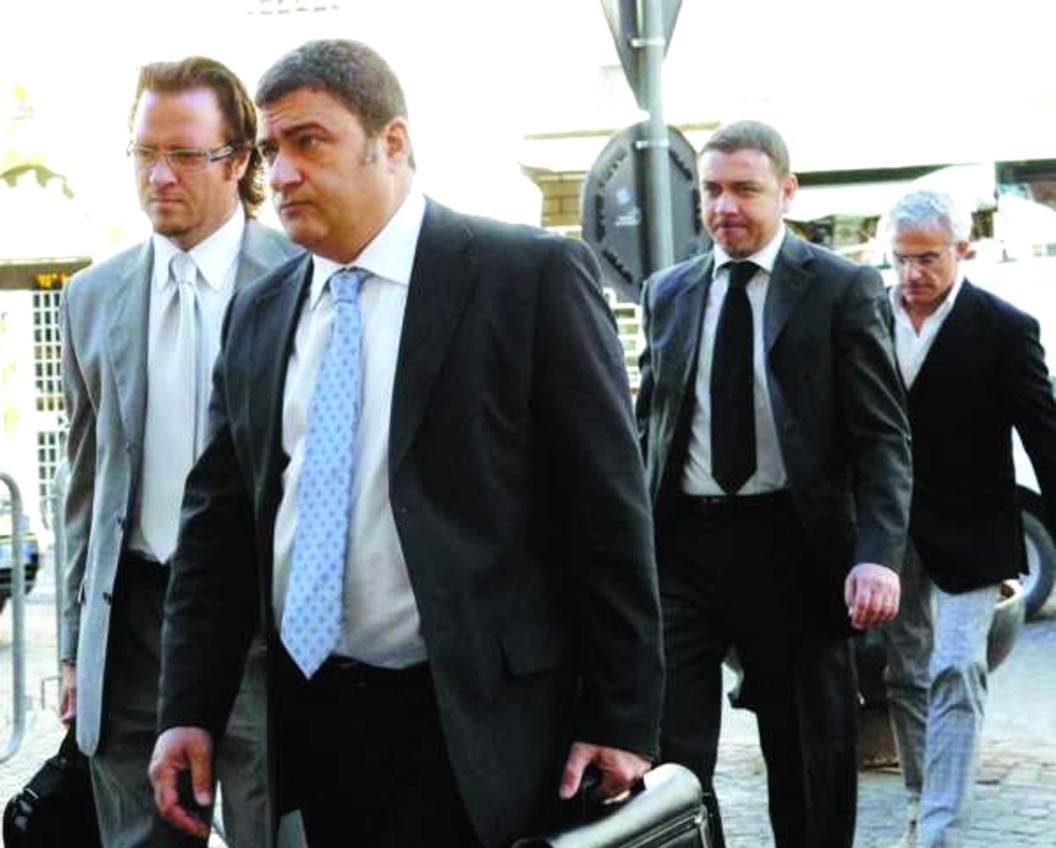
Grim-faced expert witnesses from the Violent Crimes Unit in Rome enter court
1. Reconstruction Of The Attack On Meredith
Judge Massei closed the court for much of the time. No English-language reporters were there.
Nevertheless, reports in La Nazione and other Italian media described the reconstruction of the final attack on Meredith in the court with the aid of many photographs and graphics.
Giuseppe Codispoti, Director of the Analysis of Violent Crime Unit, said in his deposition that the evidence pointed to three subjects in addition to the victim being present in the room at the time.
The evidence included the many wounds on Meredith, the state of her clothing, and the locations and shapes of the bloodstains on the walls, the wardrobe, and the floor.
Wounds to Meredith’s right hand pointed to a desperate attempt to ward off one or several attackers with knives while she was being held by her other arm.
The director of the Violent Crime department, Edgardo Giobbi, told the court that when, on the day after the murder, he handed Knox (not yet a suspect) a pair of shoe covers before entering the apartment below hers, she swiveled her hips and said “oopla.” This attitude made him turn his “investigative attention” on her, he said.
This was dramatic and telling testimony, and for some in the courtroom apparently quite hard to take.
Below: One of the images used in their detailed reconstruction of the final frenzied act in Meredith’s bedroom that suggested three people had to be involved.
2. Prior Testimony That Relates
Judge Micheli summarized the same forensic evidence and concluded for purposes of convicting Rudy Guede and of sending Knox and Sollecito to trial that it did point to three people being involved.
Judge Micheli also concluded that, as part of a cover-up, Meredith was later moved from the location below (by the wardrobe and the window) to where she was found, several feet to the left (by the bed).
3. Defensive PR Reaction To This Tough Talk
In their attempt to ridicule and undermine this compelling evidence, CBS News (48 Hours) in their recent very slanted report repeatedly showed bizarre caricatures of this scene by an Italian cartoonist.
None were remotely correct. That was not, we think, CBS News’s finest hour. They have been very silent on it since.
The paid Candace Dempsey defense blog on the Seattle PI website took a shot at ridiculing the reconstruction image above.
Something rather incoherent to do with not being specific enough about the figures. But the image above was one of a number that the witnesses used.
As real crime experts in the field would all know, it was deliberately not more specific because it incorporated only the known hard evidence.
Contacts of ours in NYC associated with law enforcement are giving the reconstruction an A. It was a careful and clever bit of work.
Trial: La Nazione On Testimony About The Attack And What The Blood Traces Suggest
Posted by Peter Quennell
La Nazione is one of Perugia’s newspapers. Click above for their early report, in Italian.
1) On today’s testimony.on what the blood traces suggest
Before Meredith died, she struggled to free herself from the constraint of one of the attackers, and she brought her left hand up to her devastated neck after the fatal knife attack. This is the evidence proven by the bloodstains found on the hand of the English student and, in particular, her index finger.
This is one of the elements that helps to reconstruct the dynamics of the crime conducted by the forensics experts of the Violent Crime Unit to be presented in today’s depositions in their case against Amanda Knox and Raffaele Sollecito accused of the murder and rape of their friend..
2) On the testimony scheduled to come next
The tight schedule of hearings ordered by the President of the Court, Giancarlo Massei, includes 5 and June 6 to hear the witnesses for the civil parties (lawyers Francesco Maresca and Serena Perna) who assist the victim’s family.
Testifying on the 5th should be the advisers (legal and medical forensic geneticist) while on the 6th it will be the turn of Meredith’s mother, Arline, and then her sister Stephanie and brother Lyle. They will talk about why she had chosen to study in Perugia, and the last telephone contacts before her murder.
On June 12th Amanda Knox is expected to be examined by her lawyers, Luciano Ghirga and Carlo Dalla Vedova. The enigmatic Seattle student might still decide to escape the barrage of questions at the last minute.
On the 13th the first witness will be Patrick Lumumba, the civil party up against the American for libelous slander. And then the witnesses for the defenses will commence testifying.
DNA Evidence: The Myths Start To Come Crashing Down
Posted by Nicki
[click for larger image; rule and annotations by Kermit]

The DNA evidence is proving to be as well-handled and as incriminating as DNA evidence ever is at such trials.
The last two hearings have very publicly exposed several of the key myths which have been aggressively propagated over the Internet and through other media for many months.
Let’s first speak about the double knife DNA. It has now become pretty obvious that:
- It doesn’t match half of Italy as falsely claimed
- It doesn’t have a 20% chance of being Meredith’s as falsely claimed
- Stefanoni never declared herself that the DNA “was unreliable” as falsely claimed
- The DNA has not been amplified “500 times” as falsely claimed
Patrizia Stefanoni has not stated that Meredith’s DNA was extracted 500 times from the knife sample, as some people with what seemed a google-level knowledge of molecular biology were claiming to muddy the waters.
The DNA was actually extracted 50 times from Meredith’s specimens and was used to compare it to other biological traces, including the one found on the knife. And it provided the forensic team with good samples to be compared to the traces found on the knife.
Two genetic profiles are identical and therefore belong to the same individual if a) they are in the same position, and b) they have identical shape and dimension. In this case, each peak produced in the original samples exactly corresponds to the peaks yielded by the knife sample, position, shape and dimension”¦ Say so long to the “matching half of Italy” myth!
Furthermore, Stefanoni excluded any possibility of contamination in the lab, stating that it had never once occurred in her lab for at least the last seven years, and every precaution was taken in order to exclude possibility of contamination so that different traces are not mixed.
Contamination during the collection phase was also excluded: the forensic team that found the knife was a different one from those who searched the cottage, so how could Meredith’s DNA possibly have been “transferred to the knife”?
Furthermore, the knife was put in a shoe box after it was bagged, and it stayed there until it reached the lab. And once again… DNA doesn’t fly, it doesn’t creep, and it sure doesnt penetrate a plastic bag!
Now let’s speak about the bra clasp.
The DNA found on the clasp has been defined as abundant and identified as belonging to Sollecito without any doubt. It should have been collected earlier in the process, but DNA evidence is often collected weeks or months after the crime when an object involved is unearthed.
The chances that it has been contaminated are at zero: the sample was found under the pillow on November 2, during the first search, and collected on December 18th when the second search took place by a different team.
During this entire time, the clasp was laying on the floor of what has been testified to have been a completely sealed crime scene. So when and how could any contamination occur?
Excluding a spontaneous migration of Sollecito “˜s DNA on the clasp from some unidentified location in the murder room or in the cottage, it could have only taken place during either the first or the second handling of the sample, so the fact that the clasp was recovered weeks later really bears no relevance.
And additionally, where could any abundant amount of Sollecito “˜s biological matter come from, if besides that on the bra clasp, the DNA corresponding to his genetic profile was only found on a cigarette butt?
Perhaps this is why Sollecito’s lawyer Ms Buongiorno is now claiming that the bra clasp was contaminated in the laboratory. She is reduced to having to claim that in effect Dr Stefanoni applies strict laboratory procedures when testing Guede”˜s or other peoples’ specimens, but somehow miserably fails when the samples belong to Sollecito and Knox.
Finally, let’s not forget that Rudy Guede’s DNA was not found “all over” the victim, but only on the right side of her bra, on the left cuff of her jumper, and inside her body. If passive transfer of DNA is so easy to happen, and if Guede is the only one who physically attacked Meredith, how comes his DNA was found only in these three places on the victim’s body?
DNA is NOT easy to transfer. Dr Stefanoni is absolutely correct when she says that “transfer of DNA must not be taken for granted nor it is easy to happen, and more likely to take place if the original trace is aqueous, not if it is dry”.
About the possibility of contamination having taken place in the lab, this is a risk that everyone working with PCR is well aware of. It is certainly not probable that it could occur every time a biological sample is tested. In fact, it is very unlikely to happen when the routine strict precautions are taken.
And there is no doubt that Dr Stefanoni was extremely cautious when handling any of these samples.
I can see the reason for the improbable reach of the defense teams: since their clients deny any involvement, the positive DNA results “must” be contaminated - what else could they possibly say? Regarding this evidence, it is the only argument that they have available.
Finally, Dr Stefanoni has an international reputation and is considered one of the best in the field today. Questioning her credentials really makes no sense at all. But those too have come under attack.
Edited to add: On the issue of DNA transfer, from today’s hearing (La Nazione)
“The contamination theory has been discussed again today: Ms Bongiorno repeatedly asked the forensic witnesses information regarding the techniques used to collect the samples found in Meredith’s house, but PM Manuela Comodi showed the Court that contamination did not occurr by asking the forensic witnesses: “Using the same gloves, you have touched the victim’s socks after working on other samples. Could you tell me what the result of the sock analyses was?”
The witness answered: “No foreign DNA nor genetic traces have been found”. Another demonstration that DNA passive transfer just doesn’t occur so easily. Differently, the probabilities of obtaining a contaminated sample would be so high that DNA testing would hardly be of any use in crime investigations.
Saturday, April 18, 2009
Trial: Another Objective Report From ABC News
Posted by Peter Quennell
[Images above and below: the lay judges and lawyers tour the crime scene]
Rome-based Ann Wise reports.
1) More on the issue of the second knife.
With journalists unable to attend the hearing, information on what Dr. Bacci said in court today came from lawyers as they emerged from the courthouse and, as always, interpretations differed.
Francesco Maresca, who represents the family of Meredith Kercher, is a firm believer in the prosecution’s theory that the murder was the result of a sex game gone wrong between all three defendants—Knox, Sollecito and Guede. He told journalists outside the courthouse that Dr. Bacci told the court that whoever attacked Kercher first tried to strangle her, and then stabbed her in the throat, possibly with two different knives.
Bacci said that the knife the prosecutors believe is the murder weapon is compatible with the largest and deepest cut in Kercher’s throat but is not compatible with another, smaller wound. This is the first time a witness for the prosecution has mentioned the possibility that more than one knife might have been used…
Maresca also told reporters that according to Dr. Bacci “injuries suggest” that Kercher had probably participated in a nonconsensual sexual act before she died.
Luca Maori, one of Sollecito’s lawyers, told journalists that based on Dr. Bacci’s conclusions, the knife prosecutors believe is the murder weapon is “only abstractly compatible” with the wounds found.
2) And more on the visit by the judges, jury and lawyers to the house - sadly, extremely disarrayed, it seems..
The afternoon was the occasion for the court in its entirety—minus the two defendants, who chose not to attend—to visit the scene of the crime. A small crowd, comprised of the two judges, six jurors and their substitutes, the prosecutors and a bevy of lawyers, gathered outside the charming cottage-with-a-view on the edge of old-town Perugia. On the road just above, another crowd of journalists and photographers and some hangers-on watched as policemen activated a generator (the electricity in the house has been cut off) and opened the door to the house.
“The court looked closely at the inside and the outside of the house,” [Prosecutor] Comodi said. The court spent a good amount of time in the room where the murder took place and discussed the position of the corpse. Carlo Dalla Vedova, a lawyer for Amanda Knox, told reporters the house “was a mess, and it was important that the jurors see this. Amanda’s clothes were thrown all over the place.”
There have been many press reports of bad forensic work and bad handling of the scene of the crime on the part of investigators, and this is expected to be an important part of the case the defense will make. The house where the crime took place has also been subjected to two break-ins in recent months, adding to the sorry state of the premises. The house is in “terrible condition,” Bongiorno said. “The mess made by the searches was compounded by the two beak-ins.”
